
The survey boat, Intrepid, could once be seen on the Ashton, Peak Forest and Macclesfield Canals. It was also known as the Committee Boat and sometimes as the Inspection Launch. The Return of Boats belonging to the Manchester, Sheffield and Lincolnshire Railway Company, dated 1 Jan 1890, shows that it was based at Fairfield on the Ashton Canal. Available evidence suggests that the original Committee Boat, owned by the Peak Forest Canal Company, might have been replaced or rebuilt when it became in need of repair. It is likely that the boat house, below Fairfield top lock (lock 18) on the Ashton Canal, was used to accommodate Intrepid when not in use.
The hull of Intrepid was shorter than that of a working boat with a cabin that was reminiscent of a first-class railway dining coach. Officially, it was a survey (inspection) boat but in reality it was a pleasure boat for the personal use of directors and other VIPs. Other canal companies operated similar boats where the management held 'meetings' during leisurely cruises through scenic countryside.
In the 1920s, when George Lucas was Inspector at the Gorton Canal Depot, the procedure was that he would receive a telephone call from the Engineer based at Guide Bridge Railway Station, who was his superior. George would be instructed to prepare Intrepid for use and arrange for her to be towed the short distance to Guide Bridge. The maintenance boat, Joel, was often used for this purpose and at Guide Bridge it would be moored below the station in readiness. Meanwhile, the staff in the station refreshment room prepared a picnic hamper, which would be put on board prior to the arrival of the VIPs by train. Once on board, the VIPs headed for the Lower Peak Forest Canal for an enjoyable cruise. Whenever Intrepid was moored at Fairfield its appearance, with starched tablecloths and gleaming silver cutlery, was a source of admiration for mill girls as they passed by.
Records of the Survey Boat
Peak Forest Canal Minute Book, 4 Apr 1833
Mr James Meadows (Junior) stated that he had had an application from the Revd Francis for the use of the Committee Boat for a Party of Pleasure, but that he had refused the loan of it on the grounds that it would be wanted this day for 2 or 3 days by the Ashton Canal Committee. He was desirous of knowing what he must do if again requested to lend it. Ordered that it must not be loaned without an order from the Committee.
Peak Forest Canal Minute Book, 3 Jul 1833
'The sub-Committee agree to pay the expense of building a Boat House jointly with the Ashton Canal Company to preserve the Committee Boat.
Another Minute, of unknown date but prior to 1846, states that the Committee Boat is in need of repair and that it should be replaced/rebuilt jointly with the Ashton Canal Company. This minute shows that more than one Committee/Survey Boat was built and available evidence suggests that the one that survived until the 1940s was the third.
A notebook giving details of each boat in the railway company's fleet (by then the London and North Eastern Railway Company) records the following service history of the Survey Boat, commencing in Apr 1889 when Intrepid was newly built. The place where she was built was unrecorded but it is likely that this was at the Gorton Canal Depot of the Manchester, Sheffield and Lincolnshire Railway Company.
Survey Boat New: 4/1889 Repainted: 9/1893 Bottom re-caulked: 6/1896 Repainted: 9/1898 Repainted: 7/1901 New Bottom Strake & 2 new planks above up to Fender all round new (illegible) floor & sheathing: 1922. New Bottom strake Put on old Bottom for first time at Gorton. All new Revits (Rivets?) done by F Hyde & E Hyde. Finished off by G H Potts new Boatbuilder.
A letter (Marple Section Letter Book, 1939-1947, Letter No. 261) written by Mr A Wood on the 25 Nov 1944 records the inventory of cutlery and crockery belonging to Intrepid:
| Item | Qty | Item | Qty |
|---|---|---|---|
| Cruet complete | 1 | Glass tumblers | 5 |
| Pewter tea pot | 1 | Glass decanter | 1 |
| Pewter coffee pot | 1 | Small oval dishes | 3 |
| Large dinner knives | 7 | Cups | 6 |
| Small knives | 12 | Saucers | 9 |
| Bread knife | 1 | Egg cups | 7 |
| Carving knife | 1 | Basins | 5 |
| Carving forks | 2 | Gravy boats | 2 |
| Teaspoons | 9 | Meat dishes | 4 |
| Pair of sugar tongs | 1 | Small plates* | 8 |
| Large dinner forks | 11 | Large dinner plates | 12 |
| Small forks | 14 | Small plates* | 12 |
| Table spoon | 1 | Large dishes | 2 |
| Corkscrew | 1 | Copper kettle | 1 |
| Tablecloth | 1 | Water can | 1 |
| Serviettes | 6 | Iron saucepan | 1 |
| Pot towel | 1 | Ordinary towel | 1 |
*The difference between these two small plates is unknown.
The above inventory of 1944 can be compared and contrasted with the following anecdotal source:
Around the time that canals were nationalised, on the 1 Jan 1948, Intrepid disappeared never to be seen again.
Prior to its final voyage into oblivion the canteen of silver cutlery, with each piece inscribed M S & L R Co, vanished much to the dismay of local canal officials.
As a consequence of this there are two unsolved mysteries. What happened to Intrepid and what happened to the canteen of silver cutlery?
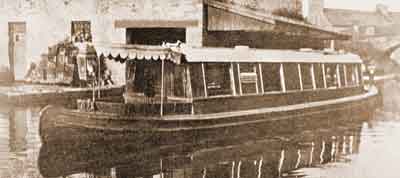 |
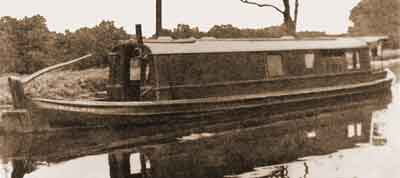 |
| Intrepid on the Macclesfield Canal, Marple, 1930s. | Intrepid at an unidentified location, 1930s. |
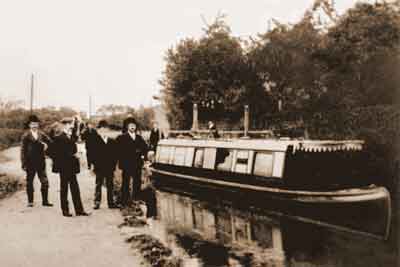 |
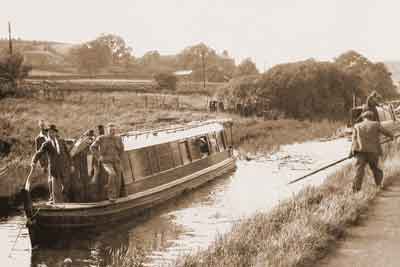 |
| Intrepid at an unidentified location, 1910. | Intrepid on the Upper Peak Forest Canal, 1940s. |
The motor boat, Scotia, was also seen on the Ashton, Peak Forest and Macclesfield Canals.
Marked LNERLY, Scotia was based in the Engineers Department at their Gorton Depot on the Stockport Branch of the Ashton Canal. She was the sister boat to Joel who was built at the depot under Mr J T Challinor. However, it is understood that Scotia was built in 1901/05, with an 18hp engine, and first saw service with the Anderton Company of Stoke-on-Trent who were canal carriers in the late 19th and early 20th centuries. Nonetheless, by 1936 she was based at the Gorton Depot.
The fate of Scotia is obscure. The most likely explanation is that parts of the boat were discovered in a Cheshire flash. Other accounts are that she was discovered broken in two on the banks of the river Mersey near Runcorn or that she was sent to Chester and was seriously damaged on the river Dee.
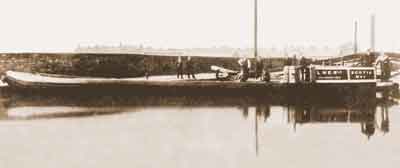
Motor Boat, Scotia, moored above Fairfield Top Lock
(Lock 18), Droylsden, late 1930s.
Motor Boat Working Instructions, 8 Mar 1941
Although these instructions were not signed, they were almost certainly issued by Leslie Machin who was the Canal Inspector at the Marple Section Office. The earliest record of him is in 1916/17.